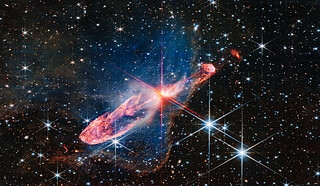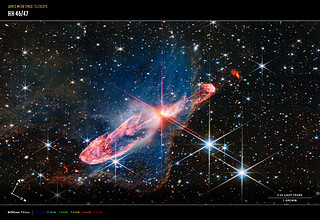weic2319 — Photo Release
Webb snaps highly detailed infrared image of actively forming stars
26 July 2023
The NASA/ESA/CSA James Webb Space Telescope has captured the ‘antics’ of a pair of actively forming young stars, known as Herbig-Haro 46/47, in a high-resolution image in near-infrared light. This is the most detailed portrait of these stars, which reside only 1470 light-years away in the constellation Vela, to date.
To find the pair of young stars, trace the bright pink and red diffraction spikes in the image until you hit the centre: the stars are within the orange-white splotch. They are buried deeply in a disc of gas and dust that feeds their growth as they continue to gain mass. The disc is not visible, but its shadow can be seen in the two dark, conical regions surrounding the central stars.
The pair of actively forming stars has sent out jets in two directions for thousands of years. Although Herbig-Haro 46/47 has been studied by many telescopes, both on the ground and in space, since the 1950s, Webb is the first to capture them at high resolution in near-infrared light. With Webb, we can now understand more of the stars’ activity — past and present — and peer through the dusty blue nebula, which appears black in visible-light images, that surrounds them. Over time, researchers will be able to glean new details about how stars form.
The most striking details are the two-sided lobes that fan out from the actively forming central stars, represented in fiery orange. Much of this material was shot out from those stars as they repeatedly ingest and eject the gas and dust that immediately surround them over thousands of years.
When material from more recent ejections runs into older material, it changes the shape of these lobes. This activity is like a large fountain being turned on and off in rapid, but random succession, leading to billowing patterns in the pool below it. Some jets send out more material and others launch at faster speeds. Why? It’s likely related to how much material fell onto the stars at a particular point in time.
The stars’ more recent ejections appear in a thread-like blue. They run just below the red diagonal diffraction spike at two o’clock. Along the right side, these ejections make clearer wavy patterns. They are disconnected at points, and end in a remarkable uneven light purple circle in the thickest orange area. Lighter blue, curly lines also emerge on the left, near the central stars, but are sometimes overshadowed by the bright red diffraction spike.
All of these jets are crucial to the star formation process itself. Ejections regulate how much mass the stars ultimately gather. (The disc of gas and dust feeding the stars is small. Imagine a band tightly tied around the stars.)
Now, turn your eye to the second most prominent feature: the effervescent blue cloud. This is a region of dense dust and gas, known both as a nebula and more formally as a Bok globule. When viewed in mainly visible light, it appears almost completely black — only a few background stars peek through. In Webb’s crisp near-infrared image, we can see into and through the gauzy layers of this cloud, bringing a lot more of Herbig-Haro 46/47 into focus, while also revealing a wide range of stars and galaxies that lie well beyond it. The nebula’s edges appear in a soft orange outline, like a backward L along the right and bottom of the image.
This nebula is significant — its presence influences the shapes of the jets shot out by the central stars. As ejected material rams into the nebula on the lower left, there is more opportunity for the jets to interact with molecules within the nebula, causing them both to light up.
There are two other areas to look at to compare the asymmetry of the two lobes. Glance toward the upper right to pick out a blobby, almost sponge-shaped ejecta that appears separate from the larger lobe. Only a few threads of the semi-transparent wisps of material point toward the larger lobe. Almost transparent, tentacle-like shapes also appear to be drifting behind it, like streamers in a cosmic wind. In contrast, at lower left, look beyond the hefty lobe to find an arc. Both are made up of material that was pushed the farthest and possibly by earlier ejections. The arcs appear to point in different directions, and may have originated from different outflows.
Take another long look at this image. Although it appears Webb has snapped Herbig-Haro 46/47 edge-on, one side is angled slightly towards Earth. Counterintuitively, it’s the smaller right half. Though the left side is larger and brighter, it is pointing away from us.
Over millions of years, the stars in Herbig-Haro 46/47 will form fully — clearing the scene of these fantastic, multihued ejections and allowing the binary stars to take centre stage against a galaxy-filled background.
Webb can reveal so much detail in Herbig-Haro 46/47 for two reasons. The object is relatively close to Earth, and Webb’s image is made up of several exposures, which adds to its depth.
More information
Webb is the largest, most powerful telescope ever launched into space. Under an international collaboration agreement, ESA provided the telescope’s launch service, using the Ariane 5 launch vehicle. Working with partners, ESA was responsible for the development and qualification of Ariane 5 adaptations for the Webb mission and for the procurement of the launch service by Arianespace. ESA also provided the workhorse spectrograph NIRSpec and 50% of the mid-infrared instrument MIRI, which was designed and built by a consortium of nationally funded European Institutes (The MIRI European Consortium) in partnership with JPL and the University of Arizona.
Webb is an international partnership between NASA, ESA and the Canadian Space Agency (CSA).
Image Credit: NASA, ESA, CSA, J. DePasquale (STScI)
Links
- Collection of Webb’s First Images
- ESA Webb Seeing Farther Interactive Brochure
- Release on STScI website
- Release on ESA website
Contacts
Bethany Downer
ESA/Webb Chief Science Communications Officer
Email: [email protected]
Ninja Menning
ESA Newsroom and Media Relations Office
Email: [email protected]
About the Release
| Release No.: | weic2319 | |
|---|---|---|




